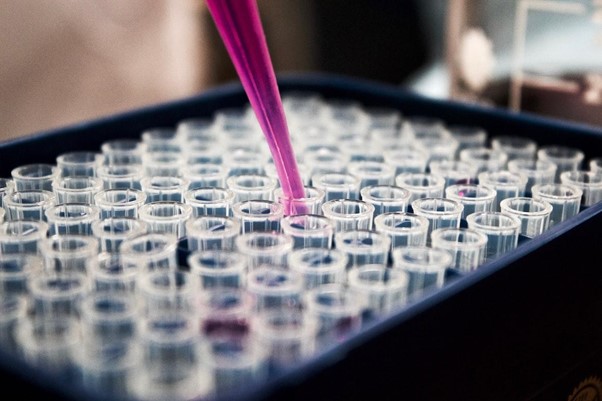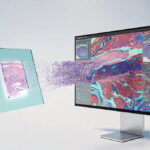Spatial transcriptomics is a transformative technique that has revolutionized the way scientists observe gene expression within tissues. By visualizing genes at a spatial level, this technology uncovers new pathways to understand the intricate relationships between genes, cells, and their surroundings.
Among various techniques to measure gene expression, in situ, hybridization methods have made significant strides. With the aid of super-resolution microscopy, they can achieve a remarkable resolution of about 10nm, fine enough to identify individual RNA molecules. Moreover, the latest advancements in these methods allow the detection of approximately 10,000 RNA species from a single sample.
This unprecedented level of detail has opened doors to exploring both the cellular and subcellular structures within tissues and individual cells. It has led to essential insights in diverse fields such as developmental biology, pathology, the study of cancer environments, and neuroscience.
Introduction to Transcriptomics
Transcriptomics is the scientific study of the complete set of RNA transcripts produced by a genome in specific conditions or within a particular cell. Traditional techniques like RNA sequencing (RNA-seq) have been instrumental in understanding gene expression but have lacked spatial context.
Spatial transcriptomics fills this gap. It adds a new layer to our understanding by preserving the spatial information of RNA molecules within a tissue sample. A significant advancement in this field is the new 10x spatial transcriptomics workflow, which enables a more detailed view of gene expression within the spatial context of tissue.
This spatial context allows researchers to see not only what genes are being expressed but also where they are being expressed, providing a more comprehensive view of biological processes.
The Importance of Spatial Context
The spatial organization of cells within tissues is crucial for understanding biological processes. Cells in different locations may have different functions, and their interactions with neighboring cells can influence their behavior. Without spatial information, traditional transcriptomics can miss these nuances. Spatial transcriptomics adds a new dimension to gene expression analysis by preserving the spatial context of RNA molecules within a tissue sample.
How Spatial Transcriptomics Works
Spatial transcriptomics combines microscopy with next-generation sequencing. The process includes:
- Tissue reparation: The tissue sample is fixed and placed on a specially designed slide containing unique barcodes.
- RNA capture: The RNA from the tissue binds to the barcodes on the slide, capturing the spatial information.
- Sequencing: The captured RNA is sequenced using next-generation sequencing techniques.
- Data analysis: Bioinformatics tools are used to map the sequenced RNA back to the barcodes, reconstructing the spatial organization of gene expression within the tissue.
Applications and Implications
Spatial transcriptomics has a wide range of applications, including:
- Cancer research: Understanding the spatial organization of tumor cells can reveal new insights into cancer progression and treatment response.
- Neuroscience: Mapping gene expression in the brain helps researchers understand neural development, function, and diseases like Alzheimer’s.
- Developmental biology: Studying how genes are expressed spatially during development can uncover the mechanisms that shape organisms.
Like any powerful technology, spatial transcriptomics raises ethical questions. The ability to manipulate gene expression in specific locations within an organism might have unexpected consequences, both in research and potential therapeutic applications.
It’s essential to approach this technology responsibly. Clear regulations, informed consent procedures, and ongoing dialogue between scientists, ethicists, and policymakers are vital to navigating the ethical landscape surrounding spatial transcriptomics.

What Spatial Transcriptomics Tells Us About How Our Cells Are Organized
Spatial transcriptomics is a groundbreaking technology that provides insights into how cells are organized within tissues. Unlike traditional transcriptomics, which lacks spatial context, spatial transcriptomics preserves the location of RNA molecules within a sample. This allows researchers to see not only what genes are being expressed but also where they are being expressed within the tissue.
By mapping gene expression in its spatial context, scientists can gain a more comprehensive understanding of biological processes and how cells interact with each other in their natural environment. This has significant implications for studying complex diseases, developmental biology, and more, offering a detailed view of gene expression within the spatial architecture of tissues.
Challenges and Future Directions in Spatial Transcriptomics
Spatial transcriptomics is an exciting field with enormous potential, but it’s not without challenges. The need for specialized equipment and expertise can make it difficult for smaller laboratories to access this technology.
Data analysis in spatial transcriptomics can be complex. It requires advanced computational tools and the know-how to interpret a large amount of information. Even with its impressive resolution, it may not capture all cellular details, particularly at the subcellular level.
However, these challenges are not insurmountable. By integrating spatial transcriptomics with other technologies and developing more user-friendly tools, we can make strides in overcoming these obstacles.
Technological Advancements in Spatial Transcriptomics
The field of spatial transcriptomics is rapidly advancing. New technologies and methods are continually being developed to improve the resolution and accuracy of spatial gene expression analysis.
These advancements are creating opportunities for more detailed and comprehensive studies, allowing researchers to explore the spatial complexities of biological systems in new ways.
Conclusion
Spatial transcriptomics is an innovative approach that enhances our comprehension of biological systems by adding a spatial perspective to gene expression. This method enables researchers to delve into the intricate connections between genes, cells, and their surroundings.
As this technology advances, it’s poised to make a significant impact across various biological research domains, opening doors to fresh avenues of exploration and creativity.
The ongoing refinement and growth of spatial transcriptomics are set to shape the trajectory of biological studies, offering unparalleled glimpses into how life operates spatially. Its capacity to transform our grasp of illnesses, growth, and core biological functions marks it as a vital instrument in the toolkit of contemporary science.
Here’s the thing: living with chronic pain is tough enough without adding mental health struggles into the mix. So start making these small changes today—your mind will thank you!
Read Also
- Automated Healthcare Software Solutions: How Intelligent Platforms Are Redefining Clinical, Administrative, and Operational ExcellenceThe healthcare industry is undergoing a seismic transformation. Rising patient volumes, value-based care models, staffing shortages, and complex regulatory demands have prompted organizations to look beyond traditional tools and embrace advanced software automation. As providers search for innovative partners capable of tailoring these sophisticated systems to real-world workflows, many turn to MCSI (Managed Care Systems,… Read more: Automated Healthcare Software Solutions: How Intelligent Platforms Are Redefining Clinical, Administrative, and Operational Excellence
- Why Whole Slide Imaging Shapes the Future of Digital PathologyWhole slide imaging has become one of the most important developments in modern pathology. It changes how tissue is examined, how cases are shared and how pathologists collaborate with the wider care team. More than a technological upgrade, it represents a shift in how laboratories think about their workflow, their storage needs and the tools… Read more: Why Whole Slide Imaging Shapes the Future of Digital Pathology
- Comparing 2025 Dental Practice Management Software OptionsSoftware Key Strengths Potential Limitations Best For Dentimax • Offers both cloud-based and on-premise/server deployment. • Tight integration between imaging (e.g. X-ray sensors) and practice management, charts, treatment planning, imaging all in one. • Transparent pricing and relatively simple UI/usability; solid for small to medium general practices. • May lack some of the… Read more: Comparing 2025 Dental Practice Management Software Options
- Top Innovations in Dermatology and Skincare TechnologiesHave you ever wondered how skincare keeps getting better year after year? From fighting acne to reducing wrinkles, today’s treatments seem more advanced than ever before. The tools and techniques used by dermatologists today are smarter, safer, and more effective than those we had just a few years ago. These breakthroughs don’t just help with… Read more: Top Innovations in Dermatology and Skincare Technologies
- Telehealth and Beyond: Building a Connected Continuum of CareHealthcare is on the verge of a radical transformation. Technology no longer simply supports medicine; it actively shapes how care is delivered and experienced. Achieving a seamless continuum demands more than deploying tools—it requires intentional design, coordinated teamwork, and innovative platforms that adapt to diverse clinical and patient needs. This article explores key strategies for… Read more: Telehealth and Beyond: Building a Connected Continuum of Care






